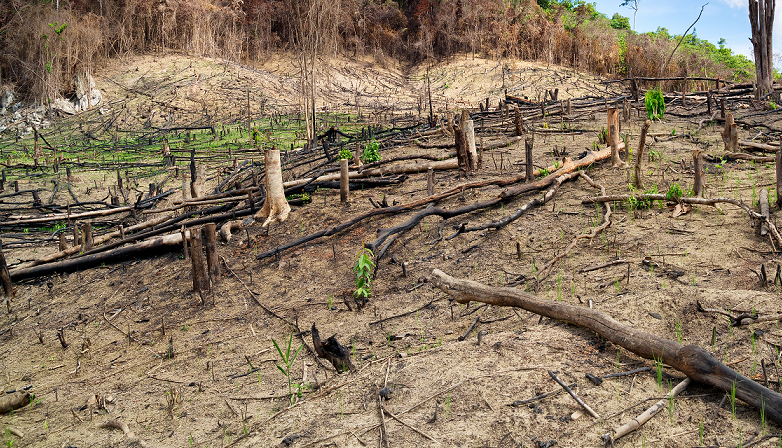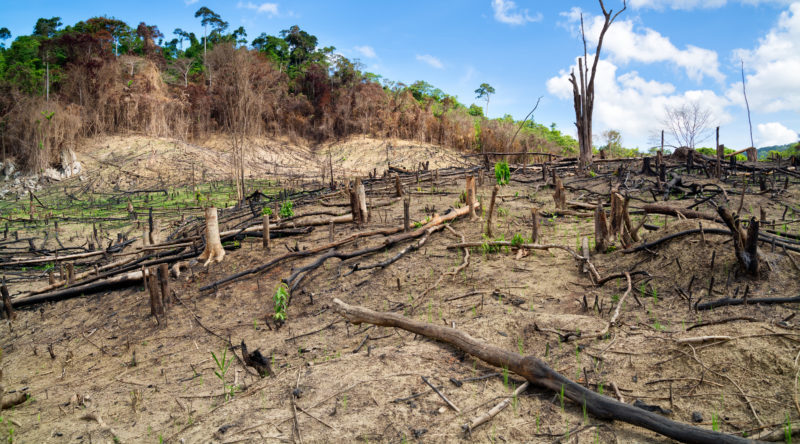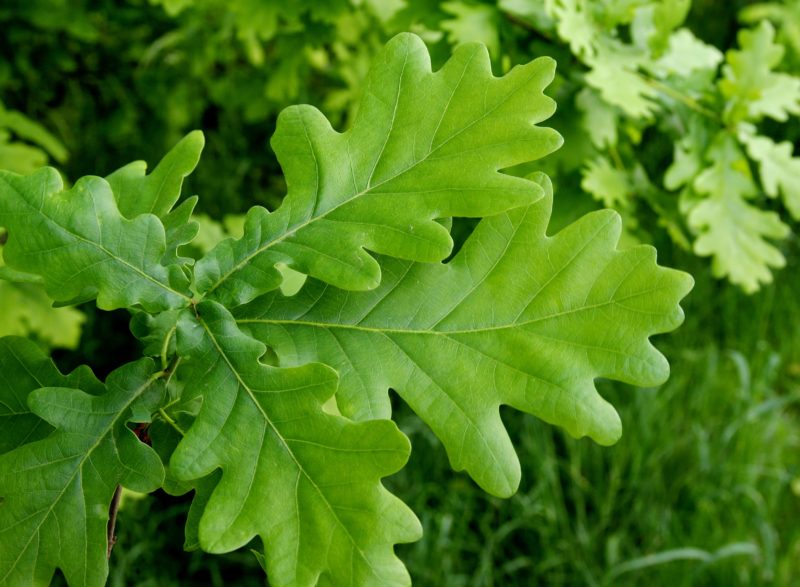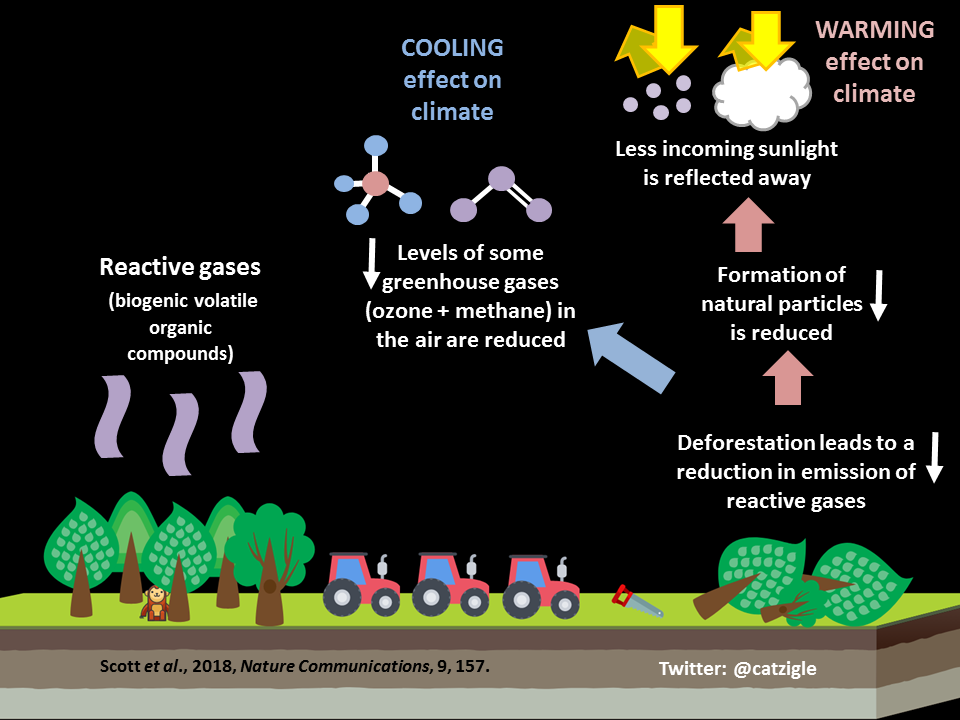New insight into climate impacts of deforestation
By Cat Scott (@catzigle) - University of Leeds
Our recent research indicates that deforestation might be warming the climate even more than we thought.

How cool are trees?
We know that trees and forests affect the climate in a variety of ways. They’re constantly taking carbon dioxide (CO2) out of the air and storing it in their roots, trunks and branches as they grow. Some of this carbon is released back into the air as the plants respire, but the overall effect is to remove CO2 from the atmosphere.
This reduction in CO2, a greenhouse gas, acts to cool the climate. When trees are cut down, we lose their ability to draw down CO2 – worse still, if they are burned the carbon they have carefully locked away will be released back into the air.
But in terms of the climate, that’s not all forests are doing. The dark colour of trees means that forested parts of the Earth absorb more of the sunlight that hits them – a bit like wearing a black t-shirt on a sunny day. The impact of trees’ dark colour is most pronounced in the snowy regions of the planet where the contrast between white snow and dark green trees is stark.

This means that the impact a forest has on the climate depends upon where it is on the planet. In particular, whilst forests in the tropics are thought to have a strong cooling effect, forests in the snowy northern latitudes of Canada and Siberia are having a slight warming effect.
Assessing the impacts of deforestation on climate
Most previous assessments of the climate impacts of deforestation have focused on the amount of carbon dioxide that would be emitted, or changes to the way the land-surface exchanges energy and water with the atmosphere. In our recent study we explored an additional impact that forests are having on the composition of the atmosphere: as well as taking in carbon dioxide and giving out oxygen, trees emit other gases that take part in complicated chemical reactions.
These gases are called biogenic volatile organic compounds (BVOCs) and they are responsible for the characteristic smell of pine forests. The compounds are made up simply of carbon and hydrogen atoms, but different BVOCs will have those atoms arranged in a different pattern.
 It takes plants quite a lot of energy to make these compounds, and it’s not completely clear why they do it. Some suggestions are that they are used for plants to signal to one another, to protect against various stresses (attack from pests, high temperatures, or ozone damage), or to inhibit other competing plants from establishing nearby.
It takes plants quite a lot of energy to make these compounds, and it’s not completely clear why they do it. Some suggestions are that they are used for plants to signal to one another, to protect against various stresses (attack from pests, high temperatures, or ozone damage), or to inhibit other competing plants from establishing nearby.
Once emitted into the air, these gases have a number of effects. They take part in complex atmospheric chemistry that can ultimately lead to an increase in the concentration of ozone and methane, which are both greenhouse gases. As with carbon dioxide, an increase in the concentration of these greenhouse gases will have a warming effect on the climate.
Scientists also think that BVOCs react and convert into more complex, “sticky” gases that are able to clump together and form nanometre scale particles (also known as aerosols) in the atmosphere. The exact identities of the molecules that have the potential to form particles are still under investigation, but it is thought that these biogenic gases are one of the important ingredients.
Although small, these particles are incredibly important for the climate because they influence the amount of the Sun’s energy that reaches the Earth’s surface. They do this in two main ways – firstly by simply reflecting some of the Sun’s energy away (we call this a direct effect) or by brightening clouds (we call this an indirect effect). This second, indirect, effect occurs because once particles in the air grow to about 100 nanometres in diameter they are able to act as a nucleus for cloud droplets to form around (these are known as cloud condensation nuclei). The more cloud droplets there are in a cloud, the brighter it appears and the more of the Sun’s energy it will reflect away.
Scientists think that the presence of particles in the atmosphere is masking some of the warming that would have occurred as a result of rising greenhouse gas levels over the past century. So, by emitting BVOCs and contributing additional particles, forests are able to have a cooling effect on the climate.
Greenhouse gases like ozone and methane that don’t remain in the atmosphere for quite as long as CO2, together with particles, are collectively referred to as short-lived climate forcers (SLCFs). We know that forests are having some warming and some cooling effects due to short-lived climate forcers, but how do they balance out – and what does this mean for deforestation?
What did we do?
To explore this we used a series of complex computer models that represent different parts of the Earth system. We found that by reducing the emission of BVOCs, deforestation reduced the levels of ozone and methane, thereby having a cooling effect on the climate (green and purple bars in diagram). But, the reduction in BVOCs also reduces the number of light-reflecting and cloud-brightening particles, which has a warming effect (red and blue bars).
When we add the impacts of all the SLCFs (orange bars in diagram), we see that the warming effect due to a reduction in particles dominates. The warming and cooling effects of these gases are most closely balanced in the tropics (bottom right panel of diagram) which is where most deforestation is occurring – suggesting that we really need to understand more about the strength of these impacts.
To appreciate the magnitude of the impacts due to changes in SLCFs, we need to compare them to the other effects of deforestation, such as carbon dioxide emission and change in surface reflectivity. When we add these effects together, we find that including the effects of SLCFs increases the warming associated with global scale deforestation by about 10%.
Scientists have known for a long time that trees emit reactive gases to the atmosphere, but the impact of these gases has not been as widely studied as the other effects of deforestation. We need to understand these complex effects on the composition of the atmosphere to get a clearer picture of the impacts of deforestation and to formulate land-use change policy for the future.
Read the full study here.


